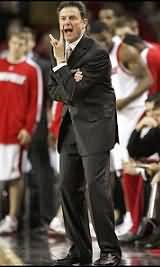Defensive Intensity - Charting Deflections
By Dr. James Gels, From the Coach’s Clipboard Basketball Playbook"Helping coaches coach better..."
Defensive "deflections" are a largely unrecognized defensive statistic that coaches should pay more attention to. Why? Because deflections are an index of defensive intensity... a measure of how hard your team and individual players are playing on defense.
Deflections are not official stats and thus are not reported in box-scores, nor by the media. You will rarely see it discussed on TV in pre-game or post-game analyses. We have good stats for offensive skills with shot charts, shooting percentages, free-throws, 2-point and 3-point shooting, assists, offensive (and defensive) rebounding, turnovers, etc. On defense, we chart blocks, steals, and rebounds but that's about it!
As coaches, we implore our players to play harder on defense, get scrappy, talk, communicate, pressure the ball, help, hustle, and a lot of intangible stuff. This is where charting your team's deflections comes in. If you have an assistant chart deflections, you will have an objective way of determining your defensive intensity. The harder you play on defense, the more deflections, and vice-versa. Deflections are a "hustle and intensity" stat.
Rick Pitino pays more attention to deflections than almost any other stat, and has been charting deflections since he started way back in the 80's. He wants to know going into a time-out or half-time, how many deflections they have. He strives for 17 - 22 at half-time and over 35 per game. He claims that if you get 35 or more, you usually win. He has an assistant devoted to nothing but charting deflections, during games and in practices. Coach Pitino's teams are noted for their defensive intensity.
Tom Crean, and other coaches, are charting deflections too. They chart deflections during games and in practices. They have assistants chart deflections during defensive drills and scrimmage type drills. Some coaches will keep a running total on the whiteboard in the locker-room. It becomes obvious who's working hard on defense, and who's not. It sends a message to players, and players develop an attitude about playing tough, hard defense and accumulating deflections... just like points and rebounds.
At halftime, you might write the number on the board, and ask, "Only 8 deflections? What do you think of our defensive intensity?"
So what counts as a deflection?
A main reason why deflections are not an official stat is because it is subjective. Coaches have their own individual rules on what counts as a deflection. This is also part of the beauty of this stat... it's flexible. You can make it whatever you want.
Examples are tipping a pass (whether it is intercepted or not), tipping a dribble, making a steal, getting a loose ball, blocking a shot, etc. You could have two deflections on one play... a player tips a pass and a team-mate recovers the ball. Both count as deflections. It could also be taking a charge, or forcing a shot-clock violation.
It does not include a rebound. Some coaches don't count shot-blocks or taking a charge, as these are often charted separately. It really comes down to whatever the coach wants to monitor. So the stat is more than just a true "deflection" or tipping of the ball. Maybe we should call it something like a "dig", a "nasty", a "scrappy", or... whatever!
Whatever you call it, make up your own rules, designate an assistant, and start charting. See if your defensive pressure intensifies.
Feel free to download and modify this "Deflections Chart" for your own use. You can get five games (or five practices) on each sheet. PDF version

